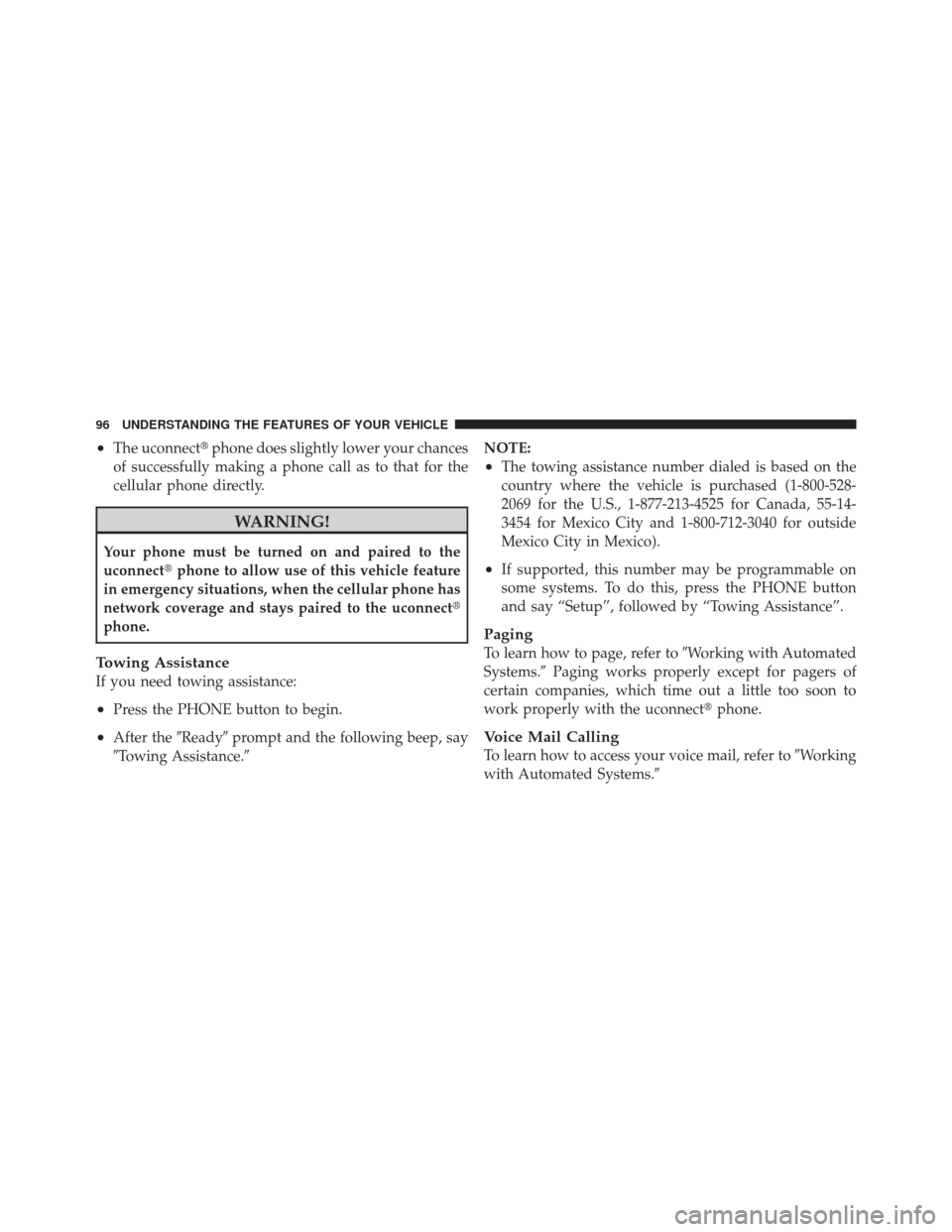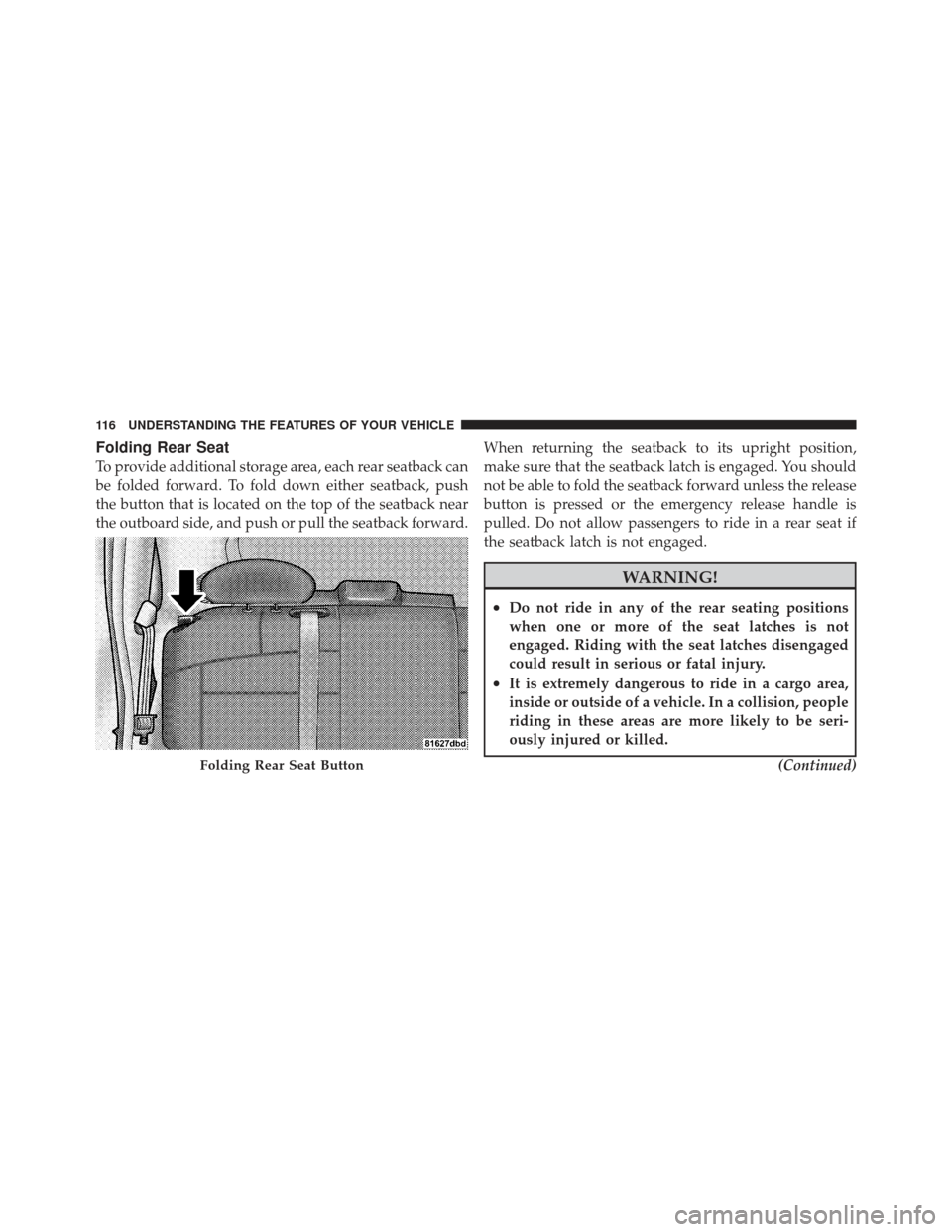Page 73 of 410
A new engine may consume some oil during its first few
thousand miles (kilometers) of operation. This should be
considered a normal part of the break-in and not inter-
preted as an indication of difficulty.
SAFETY TIPS
Transporting Passengers
NEVER TRANSPORT PASSENGERS IN THE CARGO
AREA.
WARNING!
•It is extremely dangerous to ride in a cargo area,
inside or outside of a vehicle. In a collision, people
riding in these areas are more likely to be seri-
ously injured or killed.(Continued)
WARNING! (Continued)
•Do not allow people to ride in any area of your
vehicle that is not equipped with seats and seat
belts.
•Be sure everyone in your vehicle is in a seat and
using a seat belt properly.
Exhaust Gas
WARNING!
Exhaust gases can injure or kill. They contain carbon
monoxide (CO), which is colorless and odorless.
Breathing it can make you unconscious and can
eventually poison you. To avoid breathing (CO)
follow these safety tips:
2
THINGS TO KNOW BEFORE STARTING YOUR VEHICLE 71
Page 75 of 410

Airbag Warning Light
The light should come on and remain on for six to eight
seconds as a bulb check when the ignition switch is first
turned ON. If the light is not lit during starting, see your
authorized dealer. If the light stays on, flickers, or comes
on while driving, have the system checked by an autho-
rized dealer.
Defroster
Check operation by selecting the defrost mode and place
the blower control on high speed. You should be able to
feel the air directed against the windshield. See your
authorized dealer for service if your defroster is
inoperable.
Periodic Safety Checks You Should Make Outside
the Vehicle
Tires
Examine tires for excessive tread wear and uneven wear
patterns. Check for stones, nails, glass, or other objectslodged in the tread. Inspect the tread and sidewall for
cuts and cracks. Check the wheel nuts for tightness.
Check the tires (including spare) for proper pressure.
Lights
Have someone observe the operation of exterior lights
while you work the controls. Check turn signal and high
beam indicator lights on the instrument panel.
Door Latches
Check for positive closing, latching, and locking.
Fluid Leaks
Check area under vehicle after overnight parking for fuel,
engine coolant, oil, or other fluid leaks. Also, if gasoline
fumes are detected or if fuel, power steering fluid, or
brake fluid leaks are suspected, the cause should be
located and corrected immediately.
2
THINGS TO KNOW BEFORE STARTING YOUR VEHICLE 73
Page 82 of 410
Outside Mirror — Passenger Side
Adjust the convex outside mirror so you can just see the
side of your vehicle in the part of the mirror closest to the
vehicle.
WARNING!
Vehicles and other objects seen in the passenger side
convex mirror will look smaller and farther away
than they really are. Relying too much on your
passenger side mirror could cause you to collide with
another vehicle or other object. Use your inside
mirror when judging the size or distance of a vehicle
seen in this convex mirror.
Power Mirrors — If Equipped
The power mirror switch is located to the left of the
steering column on the instrument panel. To adjust the
view in the outside mirrors, turn the rotary knob to the L
(Left), O (Center) or R (Right) position. After selecting themirror, move the knob in the same direction you want the
mirror to move. Use the O (Center) position to guard
against accidentally moving a mirror position.Power Mirror Switch
80 UNDERSTANDING THE FEATURES OF YOUR VEHICLE
Page 98 of 410

•The uconnect�phone does slightly lower your chances
of successfully making a phone call as to that for the
cellular phone directly.
WARNING!
Your phone must be turned on and paired to the
uconnect� phone to allow use of this vehicle feature
in emergency situations, when the cellular phone has
network coverage and stays paired to the uconnect �
phone.
Towing Assistance
If you need towing assistance:
•Press the PHONE button to begin.
•After the �Ready�prompt and the following beep, say
�Towing Assistance.� NOTE:
•The towing assistance number dialed is based on the
country where the vehicle is purchased (1-800-528-
2069 for the U.S., 1-877-213-4525 for Canada, 55-14-
3454 for Mexico City and 1-800-712-3040 for outside
Mexico City in Mexico).
•If supported, this number may be programmable on
some systems. To do this, press the PHONE button
and say “Setup”, followed by “Towing Assistance”.
Paging
To learn how to page, refer to
�Working with Automated
Systems.� Paging works properly except for pagers of
certain companies, which time out a little too soon to
work properly with the uconnect� phone.
Voice Mail Calling
To learn how to access your voice mail, refer to �Working
with Automated Systems.�
96 UNDERSTANDING THE FEATURES OF YOUR VEHICLE
Page 113 of 410
Using body pressure, move forward and rearward on the
seat to be sure the seat adjusters have latched.
WARNING!
•Adjusting a seat while the vehicle is moving is
dangerous. The sudden movement of the seat
could cause you to lose control. The seat belt might
not be properly adjusted and you could be injured.
Adjust the seat only while the vehicle is parked.
•Do not ride with the seatback reclined so that the
shoulder belt is no longer resting against your
chest. In a collision you could slide under the seat
belt and be seriously or even fatally injured. Use
the recliner only when the vehicle is parked.
Six-Way Power Seat With Manual Recliner — If
Equipped
The seat switch is on the outboard side of the seat near
the floor. Use this switch to move the seat up or down,
forward or rearward, or to tilt the seat.
Power Seat Switch
3
UNDERSTANDING THE FEATURES OF YOUR VEHICLE 111
Page 114 of 410
This seat also has a manual recline lever located just to
the rear of the power seat switch. To recline, lean forward
slightly before lifting the lever, then lean back to the
desired position and release the lever. Lean forward and
lift the lever to return the seatback to its normal position.WARNING!
Do not ride with the seatback reclined so that the seat
belt is no longer resting against your chest. In a
collision you could slide under the seat belt and be
seriously or even fatally injured. Use the recliner
only when the vehicle is parked.
Manual Lumbar — If Equipped
The lumbar adjustment is located on the inboard side of
the driver’s seat. To increase support, rotate the handle
down.
Recliner Control Lever
112 UNDERSTANDING THE FEATURES OF YOUR VEHICLE
Page 117 of 410
WARNING!
•Persons who are unable to feel pain to the skin
because of advanced age, chronic illness, diabetes,
spinal cord injury, medication, alcohol use, ex-
haustion or other physical condition must exercise
care when using the seat heater. It may cause burns
even at low temperatures, especially if used for
long periods of time.
•Do not place anything on the seat that insulates
against heat, such as a blanket or cushion. This
may cause the seat heater to overheat.
CAUTION!
Do not place anything on the seat that insulates
against heat, such as a blanket or cushion. This may
cause the seat heater to overheat. To avoid heated seat
surfaces coming in contact and potential seat over-
heating, always ensure that the seat heater is in the
Off position (amber lights are on for High or Low
and no amber lights for the Off position) before
placing any of the seats into a folded flat position.
3
UNDERSTANDING THE FEATURES OF YOUR VEHICLE 115
Page 118 of 410

Folding Rear Seat
To provide additional storage area, each rear seatback can
be folded forward. To fold down either seatback, push
the button that is located on the top of the seatback near
the outboard side, and push or pull the seatback forward.When returning the seatback to its upright position,
make sure that the seatback latch is engaged. You should
not be able to fold the seatback forward unless the release
button is pressed or the emergency release handle is
pulled. Do not allow passengers to ride in a rear seat if
the seatback latch is not engaged.
WARNING!
•Do not ride in any of the rear seating positions
when one or more of the seat latches is not
engaged. Riding with the seat latches disengaged
could result in serious or fatal injury.
•It is extremely dangerous to ride in a cargo area,
inside or outside of a vehicle. In a collision, people
riding in these areas are more likely to be seri-
ously injured or killed.
(Continued)
Folding Rear Seat Button
116 UNDERSTANDING THE FEATURES OF YOUR VEHICLE